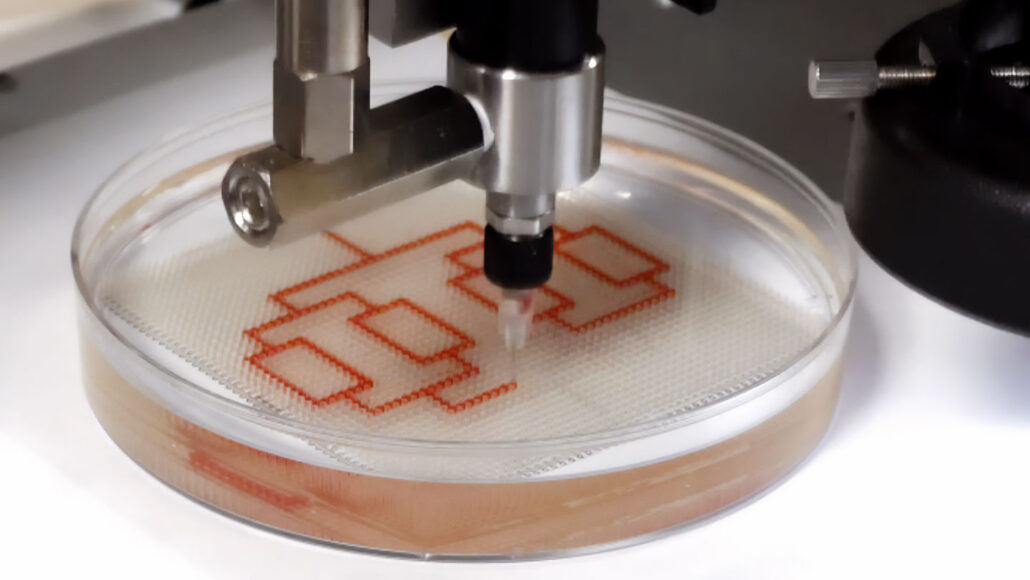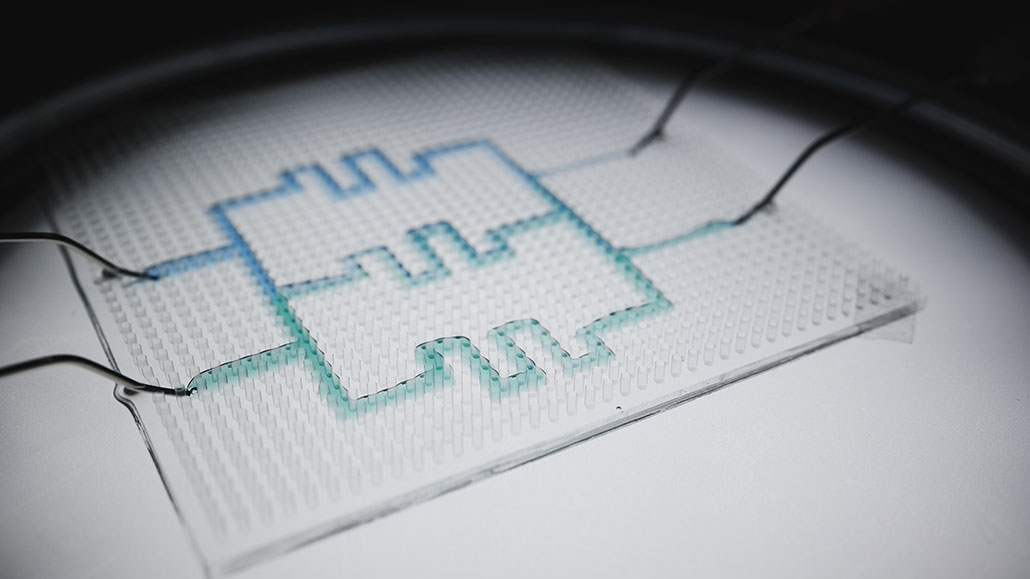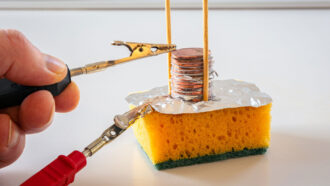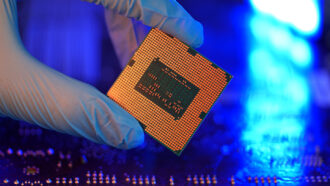Lego bricks inspired a new way to shape devices for studying liquids
The design could lead to adaptable tools to study how fluids move

A dropper builds tiny channels for liquid, one orange droplet of water at a time. These channels can be easily configured, cut or changed. In this way, researchers can quickly adjust an experiment in real time.
Courtesy Xin Du
When building devices, engineers mostly use solids, such as metal or plastic. But not a team in China. Their building blocks are drops of water. With those drops, they’ve created a system to study and manage tiny flows of liquids. Best of all, these new devices are unusually easy to build, take apart and refashion.
Their inspiration? Legos, says Xin Du. He’s a biomechanical researcher at Southeast University in Nanjing, China and led the new work.
He recalls the day a student working on this project brought in some of his son’s toys. They were building blocks that snap together. “Is it possible for us to use the same principle to fabricate a device?” Du wondered. With Legos, he noted, someone can build something, then take it apart to build something else.
Such a system might work with fluids moving through tiny tubes. Called microfluidics, this field is important in many areas of science. It can be used to study how charged liquids flow through batteries, for example. Or it can be used to analyze chemical reactions. It can even model blood flow in the body.
Du’s group described this new system February 5 in Nature Chemical Engineering.
Do you have a science question? We can help!
Submit your question here, and we might answer it an upcoming issue of Science News Explores
Presto chango
The scientists wanted a system that could easily be built, adjusted and then refashioned. This is said to be reconfigurable.
Such systems let scientists make changes quickly. If the setup of an experiment doesn’t work right, researchers can change it without starting over, explains Govind Kaigala. He is a biomedical engineer at the University of British Columbia in Vancouver, Canada.
For instance, researchers can design channels for fluids to flow through. Now they may need to go in a different direction. Changing the pattern — such as altering its direction — is easy, Du says.
“It is literally putting your hands into the experiment and altering it in real time,” says Kaigala. He did not work on the new system. But researchers in his lab design reconfigurable systems for fluids and other materials.

Educators and Parents, Sign Up for The Cheat Sheet
Weekly updates to help you use Science News Explores in the learning environment
Thank you for signing up!
There was a problem signing you up.
Du is part of a team that studies organoids. These are like artificial versions of organs found in the body. They’re made from clumps of living cells that work together like tissue. Organoids make it possible to study how living tissues work and how they might react to things such as a new medicine.
The Nanjing team designs microfluidic devices to move liquids through organoids. Building these devices is costly, Du notes, and time-consuming. Typically, channels for the liquids must be printed or carved into a solid material. To change any of those channels, the team must spend a few days to build a new device, Du says. So “the experiments are very slow.”
His group was puzzling over how to build reconfigurable systems when that student brought in the Legos. Suddenly, they all realized that when one drop of water touches another, the two stick together — much like those Lego bricks snap into place. Also like Lego bricks, two drops of water can be pulled apart.

Fencing in their liquids
The challenge was to get those droplets to touch — but not to spill out. To do this, the Nanjing team designed a grid studded with plastic pillars, which they built with a 3-D printer. Each tiny pillar stood just 5 millimeters (0.2 inch) tall and 1 millimeter (0.04 inch) wide. The pillars were placed 1 millimeter apart.
Four pillars would cage a droplet put into the space between them. And it wouldn’t spill out, though the droplet would bulge out between the pillars. When they placed another droplet in the next space over on the grid, it stayed put, too. And as it touched the first droplet, the two combined. They linked but didn’t spill out.
Drop by drop, the scientists created a long liquid path that wound through the maze of pillars. They could decide which way it would go. (Imagine you draw a grid of dots, and then fill in the square space between four dots. Then you fill in a square next to it. Eventually, you create a path through your grid.)
The first results were promising, but needed fine-tuning. At first, Du notes, drops in the grid didn’t always line up. If some stuck in the pillars higher than others, they might not link up.
The scientists solved this by immersing the whole grid in silicone oil. The oil is less dense than water, so water droplets placed between the pillars sank to the bottom of the grid and lined up neatly.
It’s possible to make varied liquid paths through the grid. Water can be pumped through a path using a nozzle at one end and letting the liquid drain out at the other end. Adjacent droplets can be separated using a piece of paper treated with a chemical that repels water. Droplets you don’t need can then be removed with the dropper to easily change the path.
Applications abound
Kaigala says he’s excited about the design. Microfluidics has many uses. Systems that can be reconfigured will offer many advantages, he says. That’s why they are a popular area of research.
Next, Du’s group wants to find ways to create far smaller channels — ones closer to the diameter of blood vessels. They also want to make a system that doesn’t require silicone oil. With such improvements, Du says, these channels could soon be useful in a variety of ways.
By using a fluid that carries an electric charge, for example, researchers could design a liquid battery. However, Du says he’s most excited about using it to design better organoids. It could supply blood or nutrients to growing cells, for instance.
“We can [now] generate fluid networks that can change, like living systems in our body,” Du says. He figures that if living tissue grows, maybe his tools should, too.







